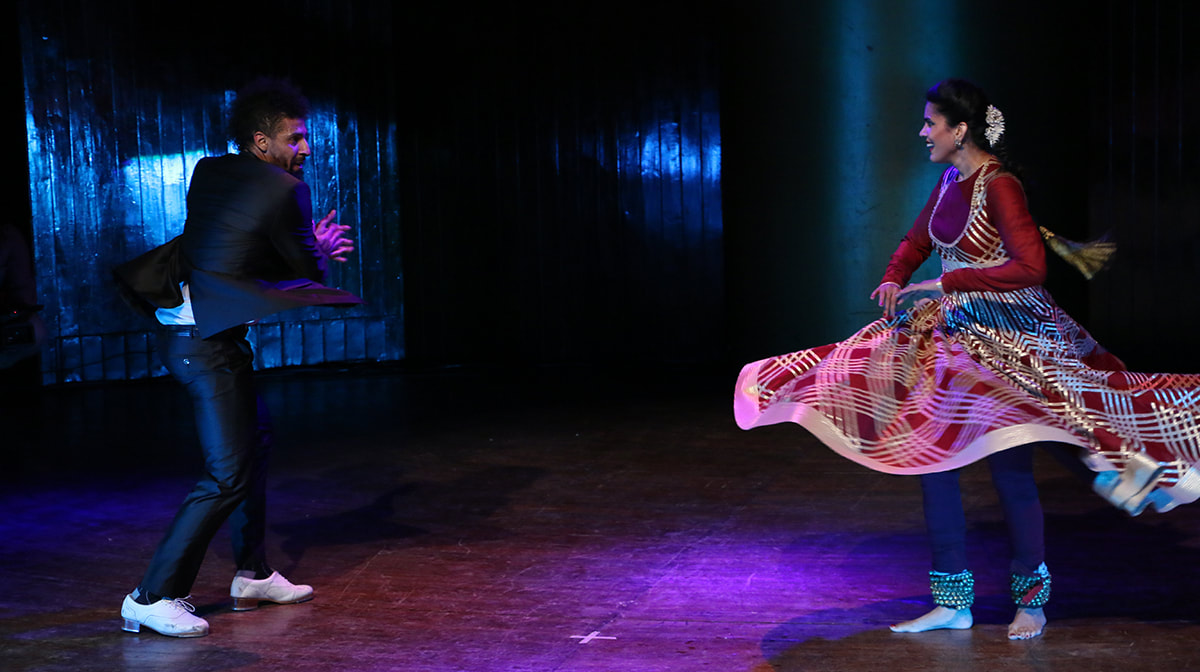|
Jason Samuels Smith and Seema Mehta in "Rhythm Rewritten: Kathak Meets Tap." They seem like an unlikely pair – tap master Jason Samuel Smith and Kathak artist Seema Mehta.
Yet with imagination, respect and joy, these two classical trained artists – from the American tradition of jazz and the ancient Hindu culture of dance and music – unspooled a surprising and enjoyable experience Saturday night at The Egg. In a program titled “Rhythm Rewritten: Kathak Meets Tap,” the two set out to demonstrate that their chosen forms have enough in common and a strong enough backbone to stand side-by-side – and battle. I admit, I approached this program with skepticism. Tap and Kathak, together? How will that work? During the first minutes of the show, I wasn’t sure it was going to work at all. This all-improvised showcase would be another forced fusion, seeking legitimacy. The first minutes of the show were devoted to Mehta who told ancient stories with her gestures. Her body spoke of lovers, of a woman warrior who fought with her baby slung to her breast and of an angry Hindu god. Listening to the intricate and expert sounds of the live musicians, singing with sitar (Jayanta Banerjee), tabla (Satyaprakash Mishra), harmonium (Dabasish Sarkar) and vocals (Joanna De Souza and Sarkar) and watching her twirling skirt flare and her hands form graceful poses, I was convinced that Mehta was so well-versed in Kathak that perhaps she could only stay in her lane. One of the more interesting things about her and all expert Kathak dancers is her ability to transform – with one spin she was a seething man, another, a sweet, timid child. These persona just appeared, real and palpable, and radiating from her being. Tap, one the other hand, was about the sound, music and rhythm. And when Mehta departed, Smith exploded onto the stage with his pianist Theo Hill (an artist who was raised and trained in the Capital Region) and bassist Ian de Souza. Smith is one of the most electric tap dancers to ever hit the boards. His athleticism is mind-boggling – he’s nearly horizon in the air when he throws his feet behind him. A few times, I was certain he would fall. He never did. He landed his sounds with accuracy. Equally entertaining was his sheer delight. Smith beamed. But nothing was more charming than Smith nailing the rhythms of the Indian musicians. Their conversation, especially between Mishra’s tabla and Smith’s feet, was incredibly complex and exuberant. Also amazing was the sounds of the jazz and Indian musicians playing together. It was powerful, like the world was waiting for them to introduce themselves. When Mehta came back for a duet with Smith, it brought it all together. Mehta matched Smith’s big presence with her precision and daring. While her bare feet can’t match the volume of Smith’s taps, she can match his moves with bells jingling on her ankles. No one – the artists or the audience – could stop smiling. It was a reach across the world that ends with mutual admiration and love. In today’s political climate, it was a respite, a brief moment of international bliss.
0 Comments
Leave a Reply. |
Wendy
|

 RSS Feed
RSS Feed
